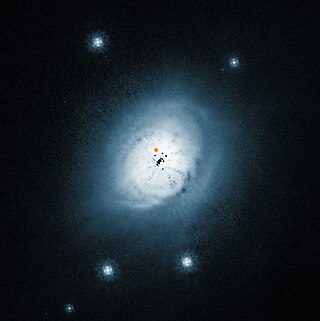
HD 100546, also known as KR Muscae, is a pre-main sequence star of spectral type B8 to A0 located 353 light-years from Earth in the southern constellation of Musca. The star is surrounded by a circumstellar disk from a distance of 0.2 to 4 AU, and again from 13 AU out to a few hundred AU, with evidence for a protoplanet forming at a distance of around 47 AU.

Z Canis Majoris (Z CMa) is a B-type star in the constellation of Canis Major. It has an average apparent visual magnitude of approximately 10, though has brightened by 1-2 magnitudes in irregular outbursts in 1987, 2000, 2004 and 2008.
HD 97048 or CU Chamaeleontis is a Herbig Ae/Be star 603 ly away in the constellation Chamaeleon. It is a variable star embedded in a dust cloud containing a stellar nursery, and is itself surrounded by a dust disk.
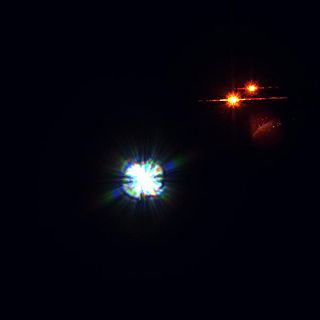
HD 141569 is an isolated Herbig Ae/Be star of spectral class A2Ve approximately 364 light-years away in the constellation of Libra. The primary star has two red dwarf companions at about nine arcseconds. In 1999, a protoplanetary disk was discovered around the star. A gap in the disk led to speculation about a possible extrasolar planet forming in the disk.

Sigma Ophiuchi, Latinized from σ Ophiuchi, is a single, orange-hued star in the equatorial constellation Ophiuchus. Its apparent visual magnitude is 4.31, which is bright enough to be faintly visible to the naked eye. The annual parallax shift of 3.62 mas as seen from Earth provides a distance estimate of roughly 900 light years. It is moving closer to the Sun with a radial velocity of −28 km/s.

HD 142527 is a binary star system in the constellation of Lupus. The primary star belongs to the Herbig Ae/Be star class, while the companion, discovered in 2012, is a red dwarf star or accreting protoplanet with a projected separation of less than 0.1″. The system is notable for its circumbinary protoplanetary disk and its discovery has helped refine models of planet formation. The orbit of companion is strongly inclined to the circumbinary protoplanetary disk.
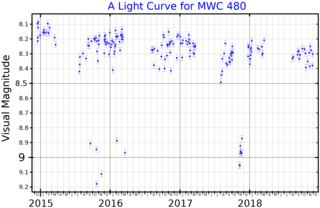
MWC 480 is a single star, about 500 light-years away in the constellation of Auriga. It is located in the Taurus-Auriga Star-Forming Region. The name refers to the Mount Wilson Catalog of B and A stars with bright hydrogen lines in their spectra. With an apparent magnitude of 7.62, it is too faint to be seen with the naked eye.
SAO 206462 is a young star, surrounded by a circumstellar disc of gas and clearly defined spiral arms. It is situated about 440 light-years away from Earth in the constellation Lupus. The presence of these spiral arms seems to be related to the existence of planets inside the disk of gas surrounding the star. The disk's diameter is about twice the size of the orbit of Pluto.

HD 259431 is a young stellar object in the constellation of Monoceros.

HD 65750, also known as V341 Carinae is a bright red giant star in the constellation Carina. It is surrounded by a prominent reflection nebula, known as IC 2220, nicknamed the Toby Jug Nebula.

HD 36112. also known as MWC 758, is a young Herbig Ae star located in the constellation Taurus, surrounded by irregular rings of cosmic dust. The system is about 3.5 million years old. The disk has a cavity at 50 astronomical units and two spiral arms at 30-75 au that are seen in near-infrared scattered light, but only one spiral arm is seen in ALMA images.

AK Scorpii is a Herbig Ae/Be star and spectroscopic binary star about 459 light-years distant in the constellation Scorpius. The star belongs to the nearby Upper Centaurus–Lupus star-forming region and the star is actively accreting material. The binary is surrounded by a circumbinary disk that was imaged with VLT/SPHERE in scattered light and with ALMA.
HD 155448 is a quintuple star system consisting of 5 young B-type stars. With an apparent magnitude of 8.72, it is too dim to be visible with the naked eye.

HD 53367 is a triple star system in the constellation of Monoceros. The primary star was identified as a variable Herbig Ae/Be star in 1989. Its companion, spectroscopically discovered in 2006, is a pre-main-sequence star star with an average separation of 1.7 AU. The star system is embedded in the extended nebula IC 2177.
HR 3831, also known as HD 83368, is a binary star system in the southern constellation of Vela at a distance of 233 light years. This object is barely visible to the naked eye as a dim, blue star with an apparent visual magnitude of 6.232. It is approaching the Earth with a heliocentric radial velocity of 4.0±0.3 km/s.
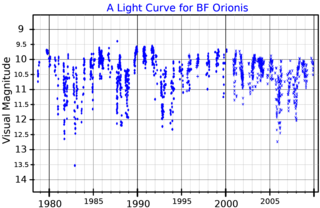
BF Orionis is a young Herbig Ae/Be star in the constellation of Orion about 1250 light years away, within the Orion Nebula. It is the most massive star of the small birth cluster of four stars.
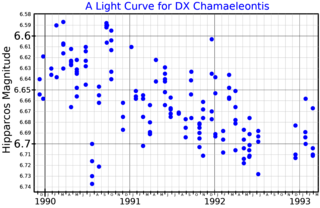
HD 104237 is a candidate multiple star system in the southern constellation of Chamaeleon. It has the variable star designation DX Chamaeleontis, abbreviated DX Cha; HD 104237 is the stellar designation from the Henry Draper Catalogue. The system is dimly visible to the naked eye with an apparent visual magnitude that ranges from 6.59 down to 6.70. It is located at a distance of approximately 348 light-years from the Sun based on parallax measurements. The system is positioned just 2′ to the north-east of the 5th magnitude star Epsilon Chamaeleontis, and is a member of the ε Cha association of co-moving stars.
HD 100453 is a binary star system which lies in the constellation Centaurus about 350 light years away from the Sun and is a member of the open cluster Scorpius–Centaurus association.

CQ Tauri is a young variable star in the equatorial constellation of Taurus. It is too faint to be visible to the naked eye with an apparent visual magnitude that ranges from 8.7 to 12.25. The distance to this star is approximately 487 light years based on parallax measurements, and it is drifting further away with a radial velocity of ~23 km/s. It appears to be part of the T-association Tau 4. CQ Tauri lies close enough to the ecliptic to undergo lunar occultations.

UX Orionis is a variable star in the constellation of Orion. It is a Herbig Ae star, located about 1000 light years from the Earth. At its brightest it is a magnitude 9.5 object, so it is too faint to be seen with the naked eye. UX Orionis is the prototype of the UX Orionis class of variable stars, which are young stellar objects that exhibit large, irregular changes in visual band brightness. UX Orionis was discovered by Henrietta Swan Leavitt.















